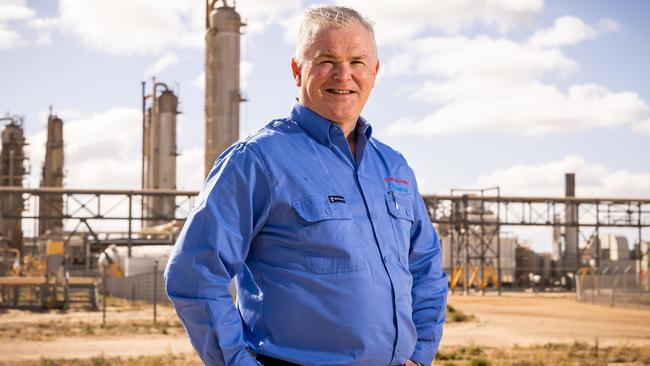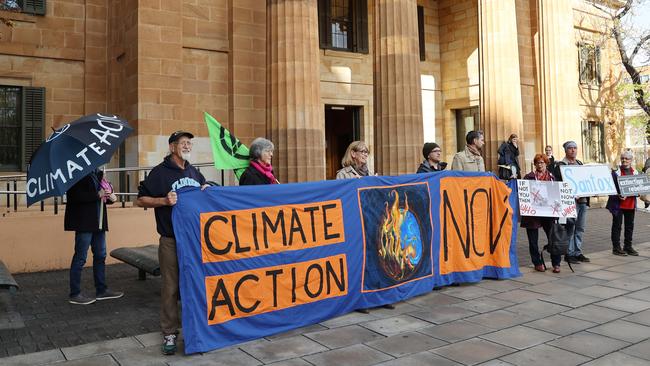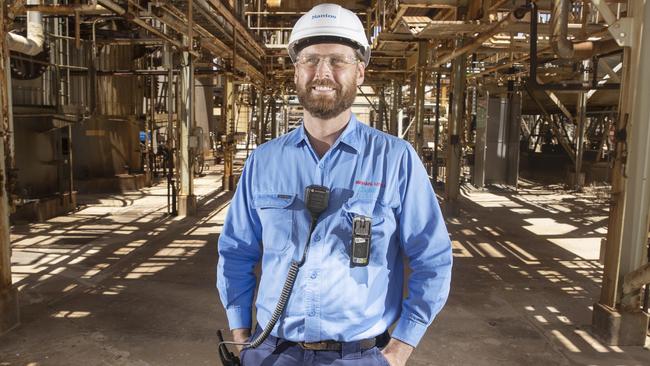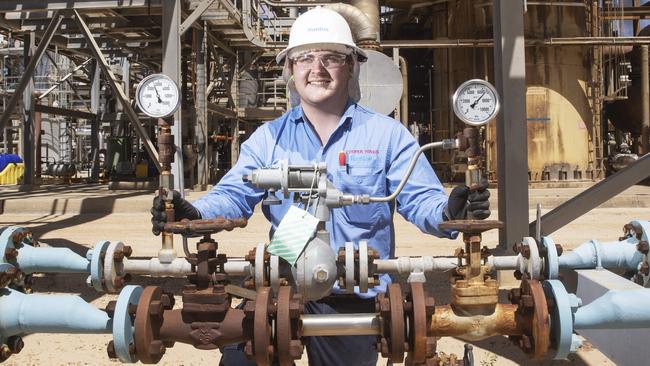Manny and Laura Fortuna contribute to the future of Santos
Manny Fortuna has been working for Santos since 1989 and now his daughter Laura has joined him on the company payroll as the company seeks to move into the future.
SA News
Don't miss out on the headlines from SA News. Followed categories will be added to My News.
Emmanuel “Manny” Fortuna moved to South Australia to work for Santos in 1989.
He planned to get some experience in the oil and gas sector and then return to his home state of Western Australia. It didn’t quite work out that way.
“I met my wife in Adelaide, got married, had three kids and the rest is history,” the 62-year-old senior measurement specialist says.
And the Fortuna history with the South Australian resources giant is far from played out, with Manny’s engineer daughter, Laura, coming on board at the Moomba plant.

And while they don’t often cross over – Manny is based in the city with occasional work in the field while Laura flies in and out of the Moomba plant on a two-week turnaround – the father-daughter duo are proud of the roles they’ve played in helping to build the operation.
“I started an apprenticeship in scientific instrument making and repairing with the Water Authority in WA,” Manny says.
“I did five years there and then changed to a company called Leeds & Northrup as a service technician servicing gold mines and iron ore mines in WA, and after seven years with them I decided I wanted to work in the oil and gas industry as I thought it was a lot more exciting than iron ore and gold. In the late eighties oil and gas was new to me, and I thought that was the exciting place to be.”
Woodside Energy wanted years of experience while Santos were willing to take a chance on the keen West Aussie, so he packed his bags and headed east.
Now Manny oversees the complicated instruments that track everything coming into and out of the Moomba plant.
“My role is to look after the custody transfer meters at Santos that look after the oil and gas that we sell to our customers, and that we purchase from joint ventures and other third parties,” he says.
“Basically, my job is to make sure everyone gets a fair price for the product they’re selling or buying.”
For plant operation engineer Laura, 27, working on Santos’s Moomba plant is a new experience but one she says she’s relishing.

“I’ve only been in this current role for a month,” the chemical engineering graduate says.
“I do two weeks on and two weeks off, and I love it. It’s very fast paced day-to-day work – this has happened today, how do we deal with it?
“Our plant is a major hazardous facility, obviously, and it’s also an older plant, so we need to manage those threats and make sure we have the right measures in place.”
And while her father helped take Santos to where it is today, Laura says she’s looking forward to taking the company into the future.
“At the moment I’m loving the challenge of learning the plant, so I’ll definitely stay here for a while. After that I might look into a business, technical or leadership role with the company.
“Looking into the future we may not always be selling natural gas – we may be selling hydrogen or storing CO2 for other customers – but the industry will be here for quite a long time.”
SAVING AN ICON FROM A $1 FIRE SALE
Three years ago Santos boss Kevin Gallagher walked into a meeting and set his team a big challenge.
How, he asked, could the company make carbon capture and storage work in a way that made sense not only from an environmental perspective but also from a market perspective?
The response, the energetic Scotsman said, was a sigh of frustration.
“They said, ‘How can we make that work economically?’,” Mr Gallagher said.
“I said, ‘That’s the challenge that I’m putting to you’, and three years later we’ve done it.”

The ambitious project will result in Santos capturing, compressing and dehydrating waste carbon at its Moomba plant to pipe to injecting wells to store it underground.
The project, Mr Gallagher said, will not only allow Santos to decarbonise natural gas production but also paves the way for the production of so-called “blue” hydrogen from this gas in the near future.
It also ensures there will be high-paid, high-skilled jobs at Moomba for decades to come.
Mr Gallagher said he now had great faith in the future of the Cooper Basin, a stark contrast to just a few years ago.
“Back in 2016 it was uneconomical, we were losing money every day, and I got offered one dollar – one dollar – from a private equity firm. There were people in Santos that day that would have recommended I take that. And here we are six years later with a bright future in front of us.”
Carbon capture and storage, Mr Gallagher said, would shore up the future of Moomba and Santos’s operations in the Cooper Basin as the producer opened up the technology to other organisations.
He said up to 20 million tonnes of carbon a year could be stored in the basin for the next half a century – far more than Santos produced.
“I wanted Santos to be at the front of the queue for decarbonising the energy supply that’s given to the markets,” the CEO said.
“It was obvious that any transition to clean energy was going to have to be market-led. That was number one. The people in the market had to be able to pay for it.
“Number two, the technology has to be there before people will commit to it. Nobody is going to buy hydrogen off of Santos until they’re sure that we can make it, transport it, and what the cost of it will be. That’s the reality.”

Mr Gallagher said debates surrounding the merits of blue hydrogen versus green hydrogen – where the fuel is extracted from water using renewable electricity – were disingenuous.
“CCS is the first step in making clean hydrogen,” he said.
“Who cares how it’s made as long as you’re not emitting CO2 while you’re doing it?
“If we can do this today instead of in 15 years’ time then why not? We should all want the world to move to hydrogen, because there are no emissions when you burn it.”
Mr Gallagher acknowledged that Santos, as a gas producer, had copped heavy criticism from environmental groups in recent years.

“I’ve just got back from PNG where in the Highlands 13 per cent of people have access to electricity,” he said.
“People crave access to energy, and that energy has to be affordable to Third World countries. The protesters don’t seem to care that the quality of life is lower, that the child mortality rate is higher.
“We look at this through a very privileged lens. I want to see these countries build like we got to build, but with decarbonised fuel. And there’s an irony in protesters gluing themselves to the road in glue made from fossil fuels.”
STAR WARS TECH IN A MAD MAX SETTING
Nobody would ever describe the Moomba gas plant as pretty, although there is a certain raw beauty to it.
Its weather-beaten towers rise out of the desert sands and the whole things feels a little Mad Max, perhaps with a touch of Star Wars.
And it is, quite literally, in the middle of nowhere. Innamincka is two hours down the Strzelecki Track, and Adelaide is 13 hours through unforgiving country, which is why virtually everyone who comes to this company town arrives by air (although occasionally some intrepid grey nomads who have misjudged their fuel situation will call in inquiring about a top-up for the 4WD).

Mick Little is the plant’s manager, and walking through the metal maze with eagles riding the desert thermals above, he cites some remarkable figures.
The plant, Mr Little says, produces on average around 300 terajoules of methane a day – that’s the gas we use to boil our kettles and heat our homes. To put that into some perspective, just one terajoule of gas would power 30 homes for a year, or fill up 2350 barbecue gas bottles.
“We also have ethane which goes through to Sydney to Qenos, our major customer for that product – that’s up to 800 tonnes a day – and on the liquid side we have a mixture of natural gas liquids and crude oil, in excess of 60,000 barrels a day. That goes down to Port Bonython where it’s split out into other products and sold.”

All of these products are coming out of the Cooper Basin, a vast area of desert lands rich in natural gas and oil that stretches across northeastern South Australia and southwestern Queensland.
It’s a vast and complicated operation, and the plant that Mr Little overseas is at the heart of it.
There are two major components to his role – overseeing the day to day operation of the plant and dealing with any issues that arise, and helping to prepare for the carbon capture storage project that will have Moomba operating well into the future.
“Carbon capture and storage is a really exciting and important next phase for Moomba, and taking 1.7 million tonnes of carbon dioxide and injecting that into the ground is really going to take Moomba into the next phase of its operating life,” Mr Little said.

Mr Little said the ambitious carbon capture project was not only good news for the environment, it was also good news for young South Australians looking to enter the oil and gas industry.
“The beauty of our industry is that there are many pathways to getting involved in the business. Anything from a trade-based background through to an engineering degree,” he said.
“The ways of entering the industry are limitless and it’s all about your enthusiasm and what you can bring to the operation.”





